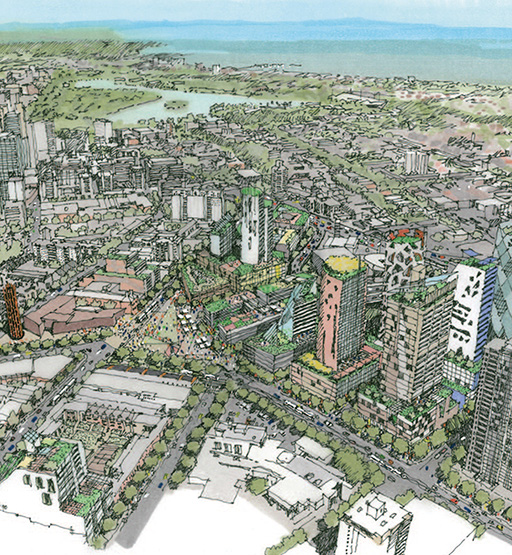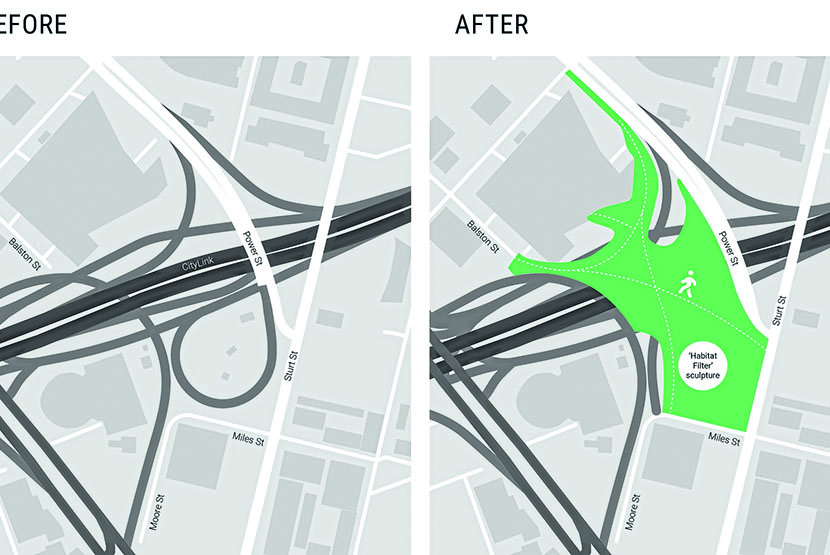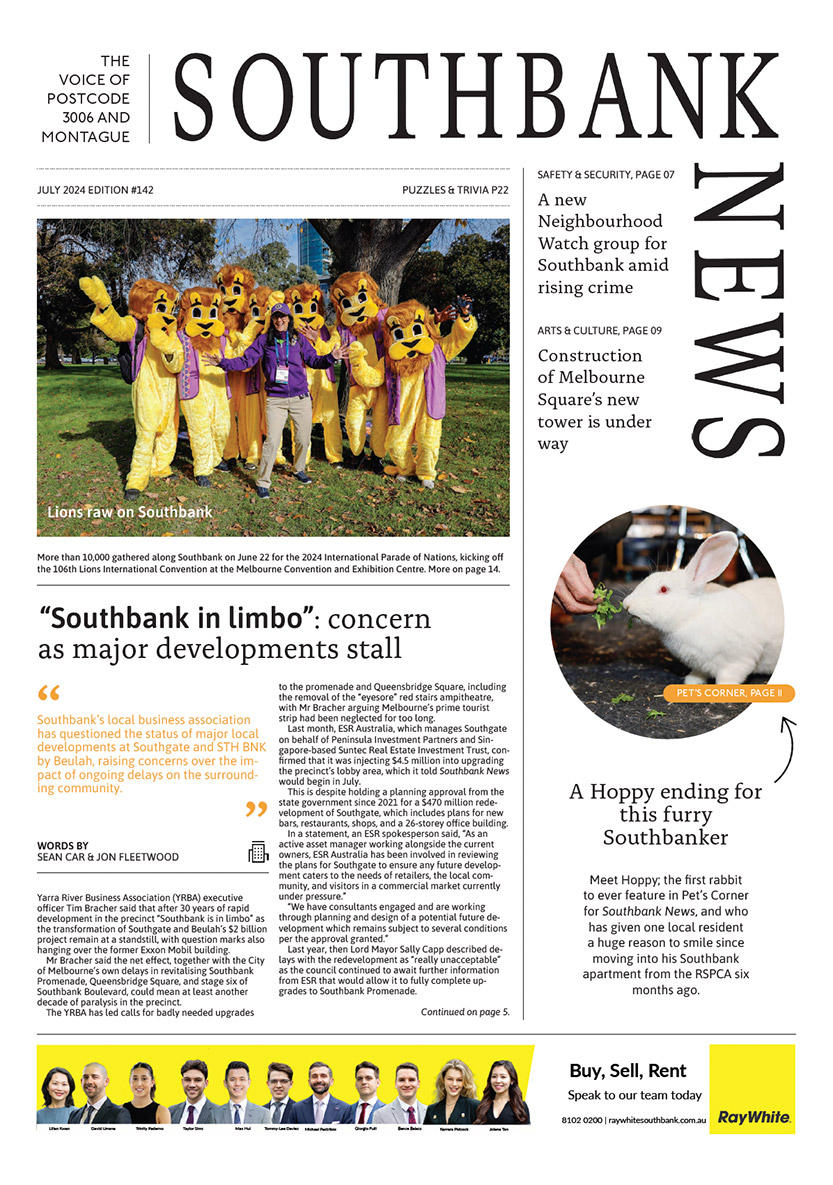Uncertainty rises over CityLink decking, as council urged to keep “dreaming big”
The vision to build an elevated park and developable space over CityLink to connect Southbank’s “two halves” might appear further away than ever, but one City of Melbourne councillor says he’s “not ready to give up on that dream”.
The ambitious vision to construct a decking over CityLink in front of the Domain Tunnel to connect the City Rd precinct with Southbank Village was mooted as the signature project in the City of Melbourne’s 2010 Southbank Structure Plan.
In unlocking 3.4 hectares of developable space above the “CityLink void”, the vision proposed in the structure plan sought to address several “key issues” in Southbank, namely a lack of open space, which remains a prominent local issue today.
But 12 years on, no master plan or formal business case for the decking of the tunnel entrance has ever been completed by the council in partnership with the state government, as recommended in the structure plan.
And, amid the ongoing challenges of the COVID-19 pandemic, as well as rising construction costs, fresh doubts have been cast over the project following the Southbank Residents’ Association’s (SRA) annual general meeting (AGM) last month.
Meeting with residents on September 21 along with Deputy Lord Mayor Nicholas Reece, the council’s general manager infrastructure Roger Teale presented an update on a “highly anticipated” audit of all Southbank plans, including the 2010 structure plan.
SRA president Tony Penna said the presentation followed on from last year’s Southbank Community Forum, whereby Mr Teale and other senior members of council management took the status of several of the plan’s components, including the decking, on notice.
In presenting the Southbank Report on Projects & Priorities, which was published on the council’s website late last year, Mr Penna said that Mr Teale had informed residents that the CityLink decking was not currently featuring in any plans for the city.
While the report stated that investigations remained ongoing into the structure plan’s second proposed “local activity node” in the Arts Precinct, the third – the CityLink deck – was not included.
In what Mr Penna described as “a massive blow” to the Southbank community, he said Mr Teale “indicated the CityLink deck was not feasible, owing to its inhibitive cost” of “somewhere around $700 million”.
In likening the project to the long-touted proposal to construct decking over the Flinders Street Station railyard as part of Federation Square East, Mr Teale is understood to have suggested the cost of such “platform-type” projects was too financially prohibitive.
Mr Penna said the information had come as a “real disappointment”.
“To only learn some 12 years after the release of the structure plan that this [CityLink decking] isn’t cost effective is a massive blow to the Southbank community, which has always believed this document would be delivered upon,” he said.
But the City of Melbourne later confirmed to Southbank News that the council had not deemed the project unfeasible, reiterating that a full business case would need to be in a form accepted and supported by the state government.
It added that given the freeway interchange was owned by the state government, “any elevated park would need significant funding support from them”.
The council’s environment portfolio lead and deputy chair of planning Cr Rohan Leppert reinforced this message, stating that, “until it changes, the council’s policy is to explore the feasibility of a deck over CityLink, incorporating significant new open space”.
“The CityLink deck is the centrepiece of the Southbank Structure Plan, featured on every map,” Cr Leppert said.
“If the council can put together a plan for funding for a project like Greenline, which relies heavily on partnerships with other levels of government, we can do the same for the CityLink deck.”
As part of their 2020 City of Melbourne election campaign, Cr Leppert and his Greens team produced the only costing for the CityLink deck to date, proposing a funding model of $385 million over 10 years through a mixture of funding streams.
This included $65 million and $30 million from the council’s open space reserve and capital works contributions, respectively, as well as a $290 million contribution from the state government, which Mr Leppert said could be recouped over time from Transurban by extending the CityLink concession deed by nine months.
While Cr Leppert acknowledged times and factors had changed significantly since then, he said it shouldn’t deter the council from continuing to “dream big”.
“Yes, it’s ambitious; yes, it’s expensive. But if it’s technically feasible we should have a crack. It would solve Southbank’s open space conundrum for good,” Cr Leppert said. “The council dreamed big in 2010, and I’m not ready to give up on that dream!”
In December last year, former Minister for Planning Richard Wynne approved Amendment C323, which introduced important planning controls to encourage the provision of arts and creative industries along Sturt St to support the next stage of the Melbourne Arts Precinct transformation.
When asked whether the CityLink decking would be considered as part of future plans for the development of the Arts Precinct’s Sturt St spine, a Victorian Government spokesperson didn’t comment, stating that it was a matter for the City of Melbourne.
Transurban was also contacted for comment but did not respond to Southbank News.
Council “getting on with the job” of addressing open space shortage
While Deputy Lord Mayor and the council’s chair of planning Nicholas Reece did not comment on the CityLink decking at SRA’s AGM, he told Southbank News that the City of Melbourne was “on the hunt” for new open space opportunities in Southbank.
The council’s 2012 open space strategy, which also cited the CityLink decking as an opportunity for a “large Capital City and municipal open space is to be established with community sport, recreation and informal use”, recommends 20 sqm per resident.
With Southbank currently sitting at around two sqm per individual, well below the World Health Organisation’s recommended minimum of nine sqm, a council spokesperson said creating much-needed green open space in Southbank was one of its “highest priorities”.
Having included $25 million over the next four years to identify and secure new open space in the area in its most recent budget, it said it was currently assessing a number of new open space sites and would “provide updates as plans progress”.
“Creating much-needed green open space in Southbank is one of our highest priorities – and we’re getting on with the job,” the council spokesperson said.
“The Southbank Structure Plan 2010 outlined an ambitious vision for the future transformation of Southbank and securing new open space.”
“Considerable work was undertaken to realise this vision – including significant new open space projects such as the Southbank Boulevard transformation, Boyd Park and Kennedy Park.”
“The City of Melbourne continues to work closely with the community, industry and developers to maximise opportunities to establish new open space.”
Cr Reece told Southbank News that the council was continuing to progress the new 1000-sqm riverfront park in front of ESSO House at Riverside Quay, as well as opening up underutilised spaces such as undercrofts for recreational uses.
The Kings Way undercroft is one such space and has long been identified as an open space project for Southbank as part of the City Road Master Plan.
The state government currently owns the undercroft and is believed to currently be offering the council a 10-year lease to manage the space, but Southbank News understands the council is seeking a more permanent arrangement.
When asked about the status of negotiations regarding the City Rd undercroft, the Victorian Government didn’t provide comment.
The council says it is continuing efforts to identify new open space opportunities, including working with industry and private owners to secure new space.
While there are very few privately owned spaces remaining in Southbank, the council is understood to be in negotiations with a number of developers about acquiring land, such as developer Holder East’s Clarendon St site.
But Mr Penna said he believed that the council would struggle to secure the land necessary for $25 million.
“I don’t think there is any land available in Southbank; well, certainly not for $25 million that will meet the practical requirements for open space,” he said.
“I can’t help but feel that maybe the reason why we are in this dilemma of open space shortage is the town planners have been using the Southbank Structure Plan to inform their planning.”
“If so, then it is understandable why there has been no serious attempts to provide the much-needed open space to Southbank if they thought the CityLink deck was always going ahead.” •

A new Neighbourhood Watch group for Southbank








 Download the Latest Edition
Download the Latest Edition